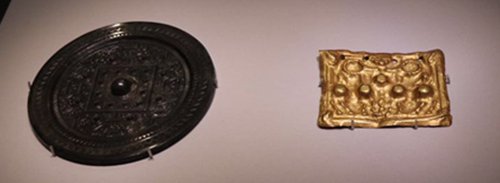
A Three Kingdoms Period (220-280) gold plate with double-deer pattern (Photo: Huang Tingting/GT)
A bronze shaped like a wild goose unearthed from the sacrificial altar of the tomb of Qinshihuang (259BC-210BC), the first emperor of China, and a gold plate with deer patterns that once belonged to ancient Xianbei aristocrats are among the many rarities on display at the Splendor and Beauty: The Archaeological Finds in Recent 20 Years in China exhibition at the Capital Museum in Beijing.
Hosted by China's State Administration of Cultural Heritage (SACH) and the Beijing Municipal Government, this is the first national-level exhibition dedicated to showing off the many archaeological discoveries that have been made in China since 1996.
Opened on Thursday, the exhibition displays a selected collection of relics from sites appearing on China's annual Top 10 New Archaeological Discoveries list over the past two decades. The exhibition is scheduled to run until August 27.
Jam packed
Arranged in chronological order, the items on display span a period of time from the Neolithic period all the way to the Qing Dynasty (1644-1911). Set in a dim hall decorated with giant metal columns, the exhibition features rare items such as a 1.2-meter-high Ashoka Pagoda unearthed at the Songchanggan Temple in Nanjing, capital of East China's Jiangsu Province, and an exquisitely made bronze drum decorated with three cavaliers unearthed at the Lijiashan Tomb in Southwest China's Yunnan Province.
"Everything has to be tightly packed together, because there are more relics here than we normally see in an exhibition," a female staff member from Chinese Museum Association surnamed Zhao told the Global Times on Thursday. "It's unusual to see so many rarities in one exhibition."
The around 400 relics on display come from the collections of 49 archaeological institutions and museums in 19 provinces and cities across China, Guan Qiang, deputy director of SACH, said at a press conference on May 9.
"This will be the first time that many of these relics have been shown outside their home musuems," Guan said at the press conference.
Another highlight of the exhibit is the relics that once belonged to famous Chinese rulers, including Emperor Yang of the Sui Dynasty (581-618) and the renowned Marquis of Haihun, the ninth emperor of the Western Han Dynasty (206BC-AD25) who stayed on the throne for a mere 27 days before being removed and later downgraded to a marquis. The discovery and excavation of their tombs, especially the tomb of the Marquis of Haihun in 2011, have been monumental events for archaeology in China, causing quite a buzz inside and outside the country.
Day of celebration
The exhibition is part of a larger series of activities celebrating International Museum Day, which fell on Thursday.
This year, aside from the Capital Museum exhibition, organizers are also planning 101 themed activities in Beijing that will include 46 exhibitions, 13 lectures and 42 events to increase public involvement with museums, organizers announced at an International Museum Day celebration held in Beijing on Thursday. Museums in other provinces including Liaoning, Shandong, Guangdong and Shaanxi also held International Museum Day activities that same day.
At the celebration event in Beijing, SACH Director Liu Yuzhu told media that the number of licensed museums in China reached 4,873 in 2016, while in recent years the average number of exhibitions held annually in China reached 30,000 and the number of annual museum visitors reached 900 million.
To promote the improvement of Chinese museums, SACH awarded several Chinese museums awards such as the Top 10 Best Exhibitions award and the Most Innovative Museum of the Country award during Thursday's celebration event.
Peter Keller, director general of the International Council of Museums (ICOM), spoke at the celebration.
During his speech at the event, Keller pointed out that 149 countries and regions took part in International Museum Day, a prominent increase over 2015. He noted that China has long been an active participant in celebrating the day.
Also part of International Museum Day celebrations, the International Alliance of Museums of the Silk Road forum, an event focusing on international cooperation with museums and cultural organizations along the Silk Road, kicked off on Thursday in Beijing.
Launched by the Chinese Museum Association, the International Silk Research Association of the Silk Road and the International Friendship Alliance of Museums along the Silk Road, the forum aims to enhance exchanges between museums concerning the protection of cultural heritages in countries and regions along Belt and Road routes.


















































